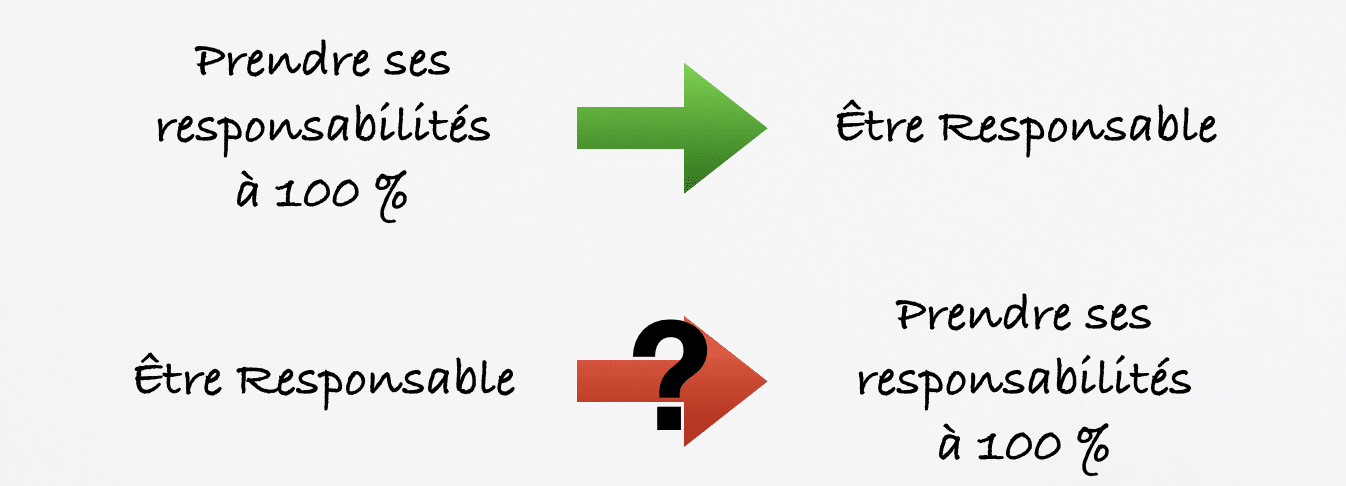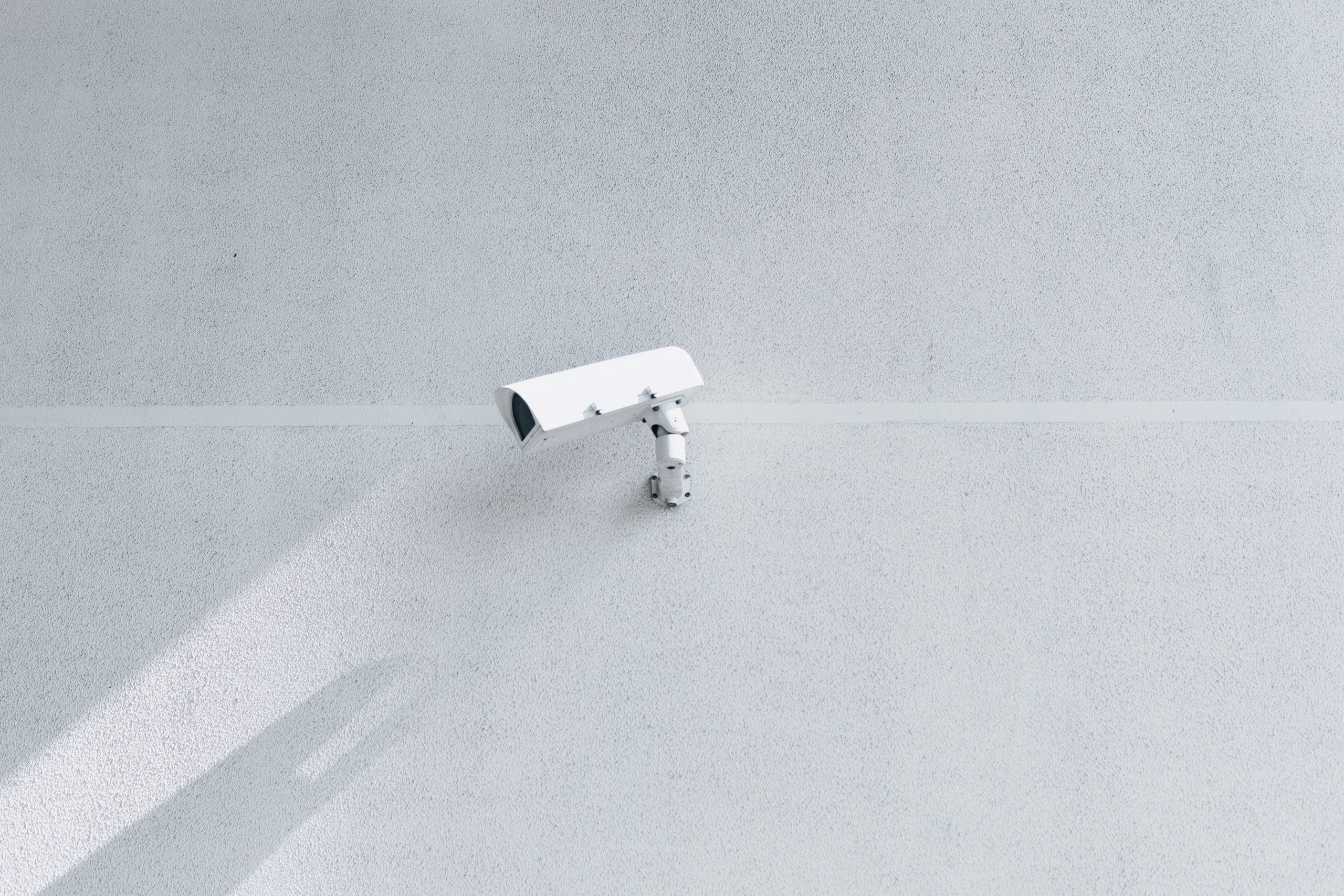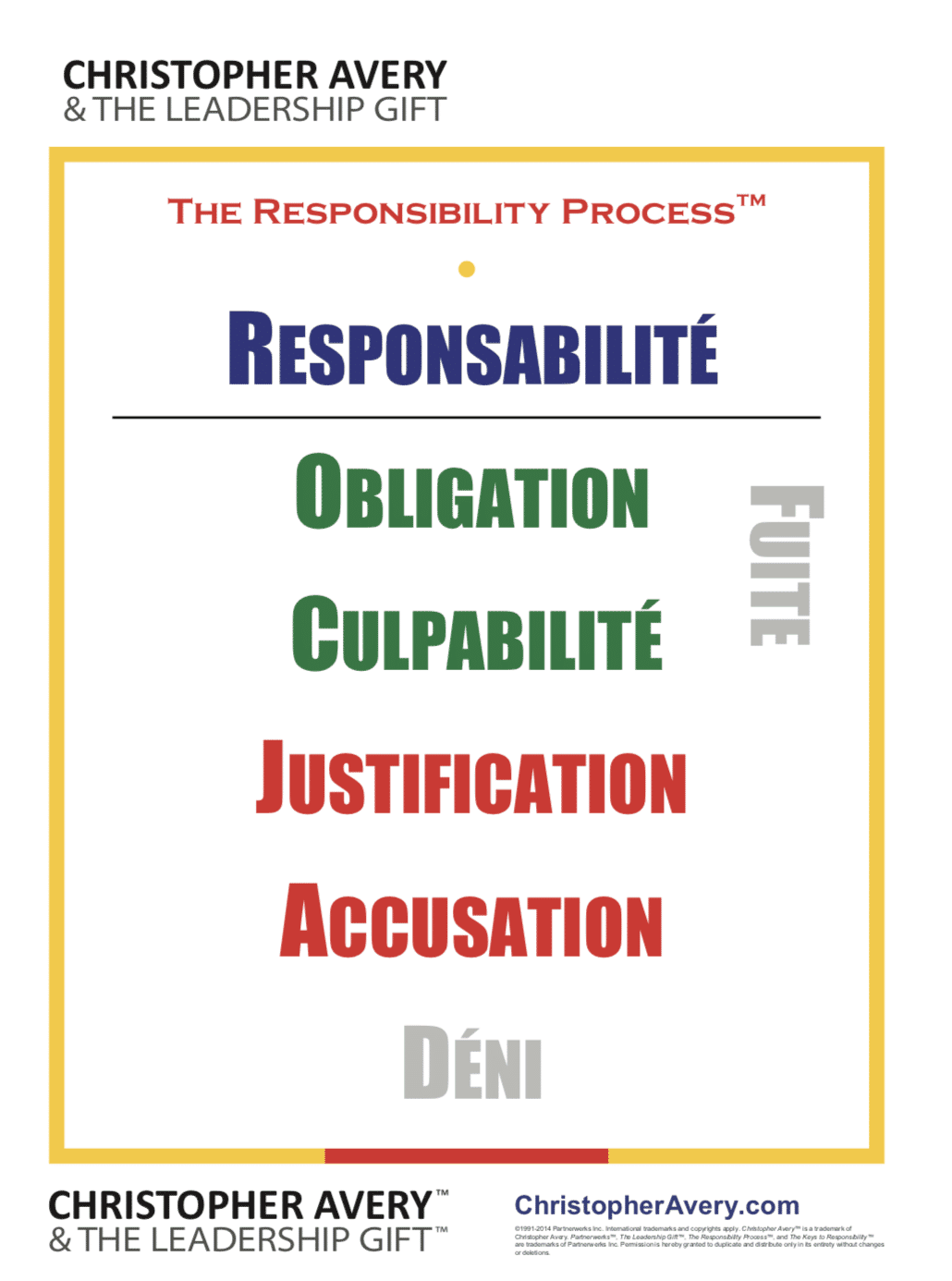Cela faisait un certain temps que je m’étais intéressé au Processus de Responsabilité de Christopher Avery mais c’est à la lecture de son livre intitulé « The Responsibility Process – Unlocking your natural ability to live and lead with Power » que j’ai décidé d’adresser le sujet un peu plus en profondeur.
En effet, j’ai eu la possibilité de le partager lors de 2 conférences cette année, notamment à MiXiT 2019 (dont vous pourrez retrouver la vidéo en fin d’article) et Agile Lyon 2019.
Je vous propose ici une transcription du contenu de ces conférences, avec potentiellement quelques éléments de détails supplémentaires ! 😉
Bonne lecture à vous !
Définitions de la Responsabilité

Avant de rentrer dans le vif du sujet, je me suis intéressé à la manière dont la Responsabilité était définie.
Pour cela, je suis allé voir sa définition dans le Larousse et j’en ai trouvé principalement 3 :
1. Obligation ou nécessité morale de répondre, de se porter garant de ses actions ou de celles des autres.
2. Fonction, position qui donne des pouvoirs de décision, mais implique que l’on en rende compte.
3. Fait pour quelque chose d’être la cause, l’origine d’un dommage.
Je vous avoue que cela ne m’a pas vendu du rêve !
Maintenant, peut-être y a-t-il une autre manière de voir la Responsabilité, et c’est ce que Christopher Avery a brillamment fait dans son livre.
Allons donc un peu plus loin ! 🙂
Responsabilité personnelle

Être responsable
Selon Christopher, être responsable c’est :Ainsi on peut en déduire que c’est :Être bien et acceptable dans les yeux d’une autre personne ou de la société.
Cela signifie recevoir l’approbation et se conformer à des attentes.
Un engagement à ressentir des sentiments de sécurité par l’approbation.
Prendre ses responsabilités à 100 %
Prendre ses responsabilités à 100 %, c’est plutôt :Même si cette expression peut apparaître un peu lourde, je l’ai trouvée vraiment pleine de sens. En effet, cela signifie qu’au travers de nos choix, on peut se voir comme la principale cause de notre bonheur ou de notre malheur, de notre succès ou de notre échec, de notre engagement ou de notre désengagement… C’est avoir la capacité de choisir sa réponse aux situations de la vie. On peut en déduire ainsi que c’est :Se voir comme une puissante force causale de notre expérience de vie.
Un engagement à être propriétaire de sa vie, au leadership personnel et à sa liberté
Same Same but Different

Même si ces 2 notions sont différentes, elles ne sont pas mutuellement exclusives.
L’engagement à prendre nos responsabilités à 100 % nous procure une forte sensation d’être responsable.
L’inverse est moins vrai. Un engagement à être responsable pourrait saper notre volonté à prendre nos responsabilités à chaque tournant : on peut facilement être arrêté par les problèmes dès lors qu’on les perçoit comme insurmontables.
En effet, comme décrit précédemment être responsable est un engagement à ressentir des sentiments de sécurité par l’approbation, non pas par la liberté, son propre leadership ou sa croissance personnelle.
Par définition être responsable compte sur des sentiments de culpabilité et d’obligation et des réponses toutes faites de déni, d’accusation et de justification.
La Responsabilité en entreprise

Lorsque l’on applique les notions précédentes au monde de l’entreprise, notre comparaison va prendre une forme un peu différente. En effet, on va comparer les notions de Responsibility et d’Accountability que l’on retrouve souvent dans le RACI, approche utilisée pour clarifier les « responsabilités », justement.
| Note : Vous pouvez voir que la langue a également ici un impact. En effet, alors que l’anglais utilise bien 2 mots différents pour 2 notions distinctes, nous n’en utilisons qu’un en français pour parler de 2 choses différentes. Je me permettrais donc d’utiliser les termes anglais par la suite pour plus de clarté. |
Accountability (Être tenu responsable)
L’Accountability ou littéralement la capacité à rendre des comptes si on nous les demande.
Elle est définie comme :
L’acte de gérer la performance et les attentes.
Ses caractéristiques sont les suivantes :
| Orienté vers les autres | on rend des comptes à d’autres personnes dont on attend l’approbation, ce qui génèrera un sentiment de sécurité |
| Focus sur le passé | on regarde ce qui a déjà été effectué pour pouvoir en rendre compte |
| Externe et indépendant de soi | cette responsabilité est rarement le fruit d’une initiative personnelle, elle nous tombe souvent dessus sans que l’on ne l’ait demandée – « tu seras responsable de la bonne ambiance dans l’équipe ! » |
Responsibility (Prendre ses responsabilités)
Si l’on décompose le terme Responsibility, on obtient :Cela donne beaucoup de sens à cette notion que l’on peut résumer à notre capacité à répondre aux situations de la vie. Une autre manière de la définir est la suivante :Responsibility = Response + Ability
Ses caractéristiques sont les suivantes :C’est un sentiment d’appropriation d’une expérience, de volonté et de capacité à prendre une action efficace
| Orienté vers soi | C’est une décision personnelle à agir vis à vis de la situation |
| Focus Présent | La question que l’on se pose est fondamentalement : « Que vais-je faire maintenant pour répondre à cette situation ? » |
| Interne | A une situation donnée, 2 personnes ne réagiront peut-être pas de la même façon. La Responsabilité est complètement interne et donc subjective |
La dictature de l’Accountability

D’après Christopher, la gestion systématique de l’Accountability est la finalité de toute organisation hiérarchique. C’est d’ailleurs une des premières raisons pour avoir une hiérarchie. On peut alors considérer l’Accountability comme un des premiers outils de management.
En effet, une organisation se construit lorsqu’il y a plus de travail à faire que la capacité d’une personne à le réaliser. On embauche alors des gens et on leur délégue le travail. C’est ce que l’on appelle le processus d’Accountability, également connu sous le nom de délégation, ou de gestion de la performance.
De manière historique, le management s’est sur-focalisé sur cet aspect d’Accountability et sous-focalisé sur la volonté et la capacité naturelle des personnes à répondre.
Pourquoi, me demanderez-vous ? Et bien si l’on pense que les personnes doivent être surveillées et mesurées pour s’assurer de leurs performances, on va alors investir dans des outils de gestion de la performance qui vont nous donner une impression de contrôle sur notre business.
| Note : Vous retrouverez ici une similitude avec la Théorie X de Douglas McGregor. |
Forger une culture de la Responsabilité, où les personnes sont présentes, s’approprient les choses et performent semble bien plus complexe et incertain que gérer les accountabilities, offrant un sentiment de certitude, même si c’est de la fausse certitude.
Ce mode de fonctionnement génère aujourd’hui de nombreux problèmes au sein des organisations – des leaders à tous les niveaux cherchant à se positionner dans la hiérarchie et considèrant que :
Tenir les gens pour compte est plus important
que de développer en eux des sentiments de responsabilité personnelle
Le résultat est simple : le travail et les travailleurs souffrent.
Piloter par l’Accountability

Plus on se focalise sur le pilotage par l’Accountability des personnes, plus on les éloigne de la prise de responsabilité.
En effet, l’Accountability repose sur une menace crédible :
Fait cela ou subis en les conséquences !
Si l’environnement pénalise les personnes prenant véritablement leurs responsabilité, c’est-à-dire démontrant une capacité à penser par soi-même et à agir de manière pro-active dans la résolution des vrais problèmes plutôt que de faire bêtement ce qu’on leur demande, alors même les meilleur(e)s éviteront de prendre leurs responsabilités et le travail en souffrira.
L’Accountability se focalise principalement sur la notion d’être responsable (être bien et en sécurité) que sur la prise de responsabilité à 100 %. Cette forme de responsabilité est donc perçue comme un processus relationnel négatif, pas positif, générant souvent la peur.
Quand la peur augmente, la responsabilité diminue.
Avec des niveaux d’appropriation et de responsabilité au plus bas, les systèmes basés sur l’Accountability tendent à devenir de plus en plus onéreux et complexes dans leur tentative de contrôler la performance. En effet, on ajoute des couches de contrôle et de documentation, les employés sont alors de plus en plus contraints et donc encore moins capables de répondre efficacement.
| Note : On pourrait faire le lien avec la dérive d’utiliser des solutions Compliquées pour répondre à des problématiques Complexes – cf. Cynefin |
Éviter la Responsabilité semble alors le chemin le plus sécurisant pour ce genre de système.
Suite à la conférence de Tristan Nitot sur le respect de la vie privée à MiXiT 2019, que je remercie, je me permets de lui emprunter sa citation de Glenn Greewald, un journaliste ayant commencé à partir de 2013 à publier les révélations d’Edward Snowden sur les programmes de surveillance de masse.Cette citation me semble donner un regard similaire, avec une portée bien plus importante, dépassant le monde de l’entreprise. Cela montre bien les dégâts qu’un tel système peut avoir sur la manière dont nous nous comportons aujourd’hui.Quand nous sommes surveillés, écoutés, notre comportement change du tout au tout. […]
Une société dans laquelle les gens peuvent être surveillés à tout moment est une société
qui pousse à la conformité, l’obéissance et la soumission,
et c’est pourquoi tous les dictateurs recherchent un tel système.”
– Glenn Greenwald, De l’importance de la vie privée
Un autre regard sur la Responsabilité

A la différence de ce que l’on pourrait croire, la Responsabilité personnelle et donc le leadership personnel sont inés en chacun de nous. Ce n’est pas un trait de caractère même si certains auront la capacité de la mettre en oeuvre plus facilement que d’autres à un instant T. C’est un processus mental qui opère chez tout le monde de manière prévisible.
Ce processus mental, le Processus de Responsabilité, régule la manière dont nous choisissons d’éviter ou de prendre nos responsabilités. Cela signifie que la responsabilité peut être systématiquement observée, enseignée et pratiquée. N’importe qui peut apprendre à maîtriser la responsabilité et n’importe qui peut développer la responsabilité dans une équipe, une famille, ou une culture de travail.
Encourager la responsabilité

Pour encourager la responsabilité chez les autres, on peut par exemple:
- Leur donner un maximum d’autonomie afin qu’ils puissent prendre leurs responsabilités;
- Leur permettre de faire des erreurs, de les corriger eux-mêmes, et d’apprendre plutôt que de chercher à prévenir leurs erreurs ou les sauver
De cette manière, on cherche simplement à reconnaître leur capacité naturelle à répondre en leur autorisant un haut degré d’autonomie et de non-intrusion. L’opposé (beaucoup de contrôles, d’évaluations, et de corrections) conditionne les personnes à devenir dépendantes de l’autorité, à ne plus penser par elles-mêmes et à trouver la liberté inconfortable.
L’organisation Responsable

Imaginons un environnement dans lequel toutes les personnes seraient en Responsabilité :
- Le niveau d’appropriation et de responsabilité personnelle des équipes serait élevé
- Le niveau d’engagement serait visible
- Le taux de productivité et par conséquent l’atteinte des objectifs ne seraient plus un problème
- Chaque personne aurait la capacité et le liberté critique de répondre oui ou non
- Le leadership personnel serait élevé
- Par conséquent on pourrait voir une auto-organisation voire une auto-direction naturelle émerger
| Note : J’ai d’ailleurs la profonde conviction que si l’on ne travaille pas sur la Responsabilité personnelle dans un premier temps, il sera difficile d’espérer voir de l’auto-organisation. |
Dans un cadre comme celui-ci, les systèmes d’Accountability peuvent être simples et légers car on n’a plus besoin de couches de surveillance et de contrôles pour nous assurer que les gens produisent les résultats escomptés. Les personnes prenant leur Responsabilité éliminent le besoin de tenir les autres pour compte. Voici ce à quoi les systèmes à haute performance ressemblent.
La Responsabilité rend l’Accountability non nécessaire.
Si vous me demandez si quelque chose sera terminé pour telle date et que je vous dis oui, vous n’aurez probablement pas besoin de me le redemander à nouveau – vous me faites confiance pour tenir mes engagements car j’ai pris mes responsabilités et j’en accepte les impacts. Si ce n’était pas le cas, je l’aurais dit.
La Transparence et l’Appropriation remplacent le besoin
de lourds systèmes de gestion de la performance
Outil #1 : le Processus de Responsabilité

Lorsque tout va bien, nous avons cette capacité à agir et à prendre des décisions de manière adaptée fort de toutes nos ressources. On appelle cela l’état mental de Responsabilité.
C’est lorsque les choses ne se passent pas comme prévu que l’anxiété prend le dessus : tout devient plus difficile, le doute s’installe et nous rentrons dans un processus enfermant nous empêchant de voir la situation avec clarté. Nous rentrons alors dans une séquence d’états mentaux que l’on appelle les états mentaux d’adaptation (coping states) : on déclenche alors le Processus de Responsabilité.
Le Processus de Responsabilité met en lumière les liens de cause à effet que nous faisons dans notre tête lorsque les choses nous embêtent et nous aide à explorer ce qui nous fait prendre ou éviter nos responsabilités. Ce dialogue mental peut autant être interne à soi qu’externe, en interaction avec son environnement ou avec d’autres personnes. Quelle qu’en soit sa nature, la sensation qui en émerge est contraignante et nous empêche d’obtenir ce que l’on veut vraiment.
Il s’avère que le pattern d’états mentaux est prédictible – d’où l’ordonnancement sur la figure ci-dessus. Nous passons tous par ces différents états mentaux, plus ou moins rapidement et avons tendance à rester bloqué à un endroit particulier. C’est l’observation qui va nous aider à repérer et dépasser ces états mentaux d’adaptation pour atteindre l’état mental de Responsabilité plus souvent.
Rentrons un peu plus en détails dans chacun des états mentaux :Accusation
C’est ta faute !
C’est par cet état mental que nous rentrons de manière automatique : c’est la porte d’entrée du Processus de Responsabilité.
En effet, l’Accusation est déclenchée par nos émotions – lorsqu’une problématique émerge – et non pas par notre intellect.
On va tenir l’autre comme fautif de ce qui nous arrive et on va lui rediriger toute notre anxiété à ce sujet. C’est une mentalité de victime où l’on donne toute notre capacité à répondre à l’autre.
Justification
En dépassant l’Accusation, on comprend que blâmer une personne n’a pas d’intérêt. On va alors blâmer la situation pour ce qu’elle nous apporte d’inconfortable ! On utilise alors souvent des excuses pour justifier que les choses sont telles qu’elles le sont. On se considère alors comme victime de la situation contre laquelle on ne peut rien faire.On a toujours fait comme ça !
Culpabilité
En dépassant la Justification, on comprend que le problème n’est peut-être pas ailleurs et qu’il y a des chances pour que l’on y ait contribué. On comment alors à se blâmer soi-même pour ce qui nous arrive – ce qui est souvent ressenti sous la forme de Culpabilité.Je n’ai pas fait assez d’effort !
Le postulat est que l’on manque de ce que l’on a besoin et que l’on a pas ce qu’il faut pour s’en sortir. On pense que le problème est mérité car on n’aurait pas dû faire telle ou telle action qui nous a mené jusqu’à cette situation.
En résumé : On se sent mal parce qu’il nous manque quelque chose et que l’on mérite de se sentir mal à ce sujet. Non seulement on peut en avoir honte, mais on se sent également coupable.| Note : Le terme original est d’ailleurs « Shame ». |
Obligation
Je dois aller à ce meeting.
En dépassant la Culpabilité, on se met en mouvement pour se débarrasser vite fait de cette source d’anxiété. On fait alors ce que l’on doit faire plutôt que ce que l’on veut faire.
On se sent piégé et on a l’impression de devoir :
- Faire quelque chose que l’on ne veut pas faire (action)
- Être quelqu’un que l’on ne veut pas être (identité)
- Avoir quelque chose que l’on ne veut pas avoir (expérience)
C’est une combinaison destructrice qui sait emprisonner les personnes les plus brillantes et ambitieuses.
Notre culture renforce le fait que tenir ses engagements est une bonne chose même si on ne les aime pas : « Arrête de te plaindre », « Fais ce qui est bien ».
Cependant, l’Obligation est non seulement un état mental mais également un état de ressenti. Il ne se réfère pas à l’engagement lui-même mais à ce que l’on ressent à son sujet. Ce sont 2 choses bien différentes.
En effet, lorsque l’on est en Obligation, notre motivation est basse et on éprouve de la rancoeur à être dans la situation. Ce conflit qui existe entre ce que l’on veut et ce que l’on a produit du stress et de l’anxiété.
A savoir que la rancoeur est un virus qui grandit au fur et à mesure – plus on a ce dont on ne veut pas – et qui se partage ! On attire naturellement les autres personnes avec cette même rancoeur et l’on amplifie notre cynisme et nos sarcasmes ensemble !
Fuite
Encore 3 semaines, 2 jours et 1 heure avant les vacances.
La fuite est un état mental particulier dans le sens où l’on y fait appel lorsque la souffrance liée à la Culpabilité et l’Obligation est trop forte. En effet, l’anxiété tend à s’accumuler là-bas.
On pense que l’on ne peut pas avoir ce que l’on souhaite. On met alors le problème au parking mais ce n’est qu’un stockage temporaire, il va revenir. On se désengage plutôt que d’y faire face.Éviter nous empêche d’apprendre et surtout cela signifie que l’on garde le problème à notre porte.
Déni
Le Déni est l’état mental dans lequel on n’a pas encore pris conscience de l’existence du problème.Quel problème ?
Responsabilité
Dans l’état mental de Responsabilité, on a la capacité et le pouvoir de créer, choisir et attirer ce que l’on veut vraiment. On se sent libre, ouvert, expansif et on a de la place pour penser et explorer de nouvelles choses. On est libre de choisir et exempt d’idées préconçus à propos d’un problème ou d’une solution donc prêt à ré-examiner la situation sous un angle différent.Je choisis d’aller à ce meeting pour en ressortir avec une décision.
On a suffisamment confiance en nos ressources propres (intelligence, créativité) et en sécurité pour confronter avec courage les situations de la vie.
Récapitulatif
| État mental | Exemple | Diagnostic | Remède | Stratégie de sortie |
| Accusation | Le client n’a pas été clair sur ce qu’il voulait ! |
L’autre est fautif et je ne peux rien faire. |
L’autre doit changer. |
Refuser de blâmer l’autre. |
| Justification |
On a toujours fait comme ça ! |
La situation est responsable et je ne peux rien faire. |
C’est la situation qui doit changer |
Refuser de croire à son histoire. |
| Culpabilité |
Je n’ai pas fait assez d’effort ! |
C’est ma faute, je le mérite. Je ne peux rien faire. |
Je dois changer. |
Arrêter de s’auto-flageller. |
| Obligation |
Je dois aller à ce meeting. |
Je n’ai pas le choix. |
Faire le minimum pour s’en débarrasser. |
Refuser de se sentir piégé. |
| Fuite |
Encore 3 semaines, 2 jours et 1 heure avant les vacances. |
C’est trop douloureux, je ne peux rien y faire. |
Abandonner, se désengager. |
Refuser de laisser le problème au parking. |
| Déni |
Quel problème ? |
|||
| Responsabilité |
Je choisis d’aller à ce meeting pour en ressortir avec une décision. |
J’ai ce qu’il faut pour traiter ce problème |
Faire face à la douleur et résoudre le problème pour de bon. |
|
Rester sous la ligne

- On considère que le problème est plus fort que nous
- On peut avoir des sensations d’enfermement, de mal-être
- On peut avoir tendance à se plaindre et à être cynique
- On subit la situation
Lorsqu’on est sous la ligne,
on parle plus du problème qu’on ne le traite.
Aller au-dessus de la ligne

- On refuse d’accepter la réponse automatique de notre esprit
- On voit le problème autrement
- On peut ressentir des sensations de liberté et de légèreté
- On considère avoir les ressources nécessaires pour répondre au problème
Lorsqu’on est au-dessus de la ligne,
on a plus de ce que l’on veut et moins de ce que l’on ne veut pas.
Outil # 2 : les 3 Clés de la Responsabilité

Intention (la clé de la réussite)

Voici quelques pistes pour apprendre à maîtriser l’Intention :Aborder les situations de la vie avec l’intention d’opérer depuis l’état mental de Responsabilité
- Se permettre de « vouloir«
- Abandonner le « devoir » (les conseils que l’on se donne à soi-même) comme « je devrais faire ceci« , « je devrais être cela«
- Lorsque l’on est contrarié(e) ou incertain(e), se poser la question : « Qu’est-ce que je veux ?«
- Lister fréquemment ce que l’on veut – incluant des éléments d’identité (Être), d’action (Faire) et d’expérience (Avoir).
- Exprimer ses victoires – une intention satisfaite – quelqu’en soit la taille :
Awareness (la clé du changement)

Voici quelques pistes pour apprendre à développer l’Awareness :Observer sans jugement l’état mental dans lequel on se trouve
- Arrêter d’évaluer et de juger, commencer à observer
- Comprendre ses biais
- Essayer différents points de vue
- Examiner ses peurs
Confront (la clé de l’évolution)

Pour apprendre à faire face et à pratiquer le Confront, voici une piste proposée par WikiHow :Faire face à son conflit intérieur pour dépasser le problème
- Accepter sa situation actuelle
- Identifier le déni
- Pratiquer l’acceptation radicale
- Identifier sa part dans la création de cette situation
- Penser à quoi on voudrait que sa vie ressemble
2. Travailler sur ses sentiments
- Écrire un journal
- Pratiquer la pleine conscience (mindfulness)
- Exprimer de la gratitude pour ce que l’on a
- Challenger ses pensées négatives
- Pratiquer des activités apaisantes pour soi
3. Créer un futur meilleur
- Se focaliser sur ce que l’on contrôler
- Décider de ce que l’on veut pour soi dans le futur
- Faire un plan pour atteindre son but
Conclusion

Il est important de garder en tête que le Processus de Responsabilité ne fonctionne que si l’on se l’applique à soi-même (comme tout outil de développement personnel qui se respecte).
C’est un outil extrêmement puissant par sa simplicité et qui nous aide à réapprendre à vouloir plus qu’à devoir.
Maintenant, comment faire pour que les autres puissent en faire également usage ? Et bien partagez-le autour de vous et démontrez-le, jour après jour.
| Note : Prenez garde à ne pas imposer la Responsabilité, sinon vous aurez de l’Obligation. De même pour vous, si vous vous imposez vous-même la Responsabilité, vous aurez de la Culpabilité ou de l’Obligation. |







4 réponses
Un immense merci pour cet article passionnant !
Je crois comprendre que « L’état mental de Responsabilité » est également promu en CNV qui rappelle que nous sommes bien toujours en train de faire des choix, y compris parfois déplaisants, et qu’il est sain d’en avoir conscience.
Merci Olivier pour cette synthèse
Un truc rigolo : « Response + Ability » c’est le titre du livre d’avril 2001 (donc écrit avant parution du manifeste agile) sur l’agilité de Rick Dove, co-auteur d’Agile 91
The Language, Structure, and Culture of the Agile Enterprise
https://www.amazon.fr/Response-Ability-Language-Structure-Enterprise/dp/0471350184
Un super article doublé d’une belle présentation à l’Agile Tour Aix-Marseille 2019!
Je suis tombé par hasard sur un tweet évoquant les »Theory X and Theory Y », Tu dois déjà connaitre:
[extrait de Wikipedia]: « Les théories X et Y sont des théories développées dans les années 1960 par Douglas McGregor et utilisées en ressources humaines et en comportement de l’organisation.
Les deux théories s’opposent entre elles. La première suppose que l’homme n’aime pas travailler, la seconde affirme le point de vue inverse. Ces deux théories sont issues d’observations empiriques et sont formulées de manière à rendre compte des comportements observés dans les organisations, selon les postulats des dirigeants. »
j’aime bien la théorie X ;-), je trouve qu’il y a un lien avec cet article et probablement avec le livre de Christopher Avery.
Je viens de voir que tu sites la Theory X dans ton talk « MIXIT19 »